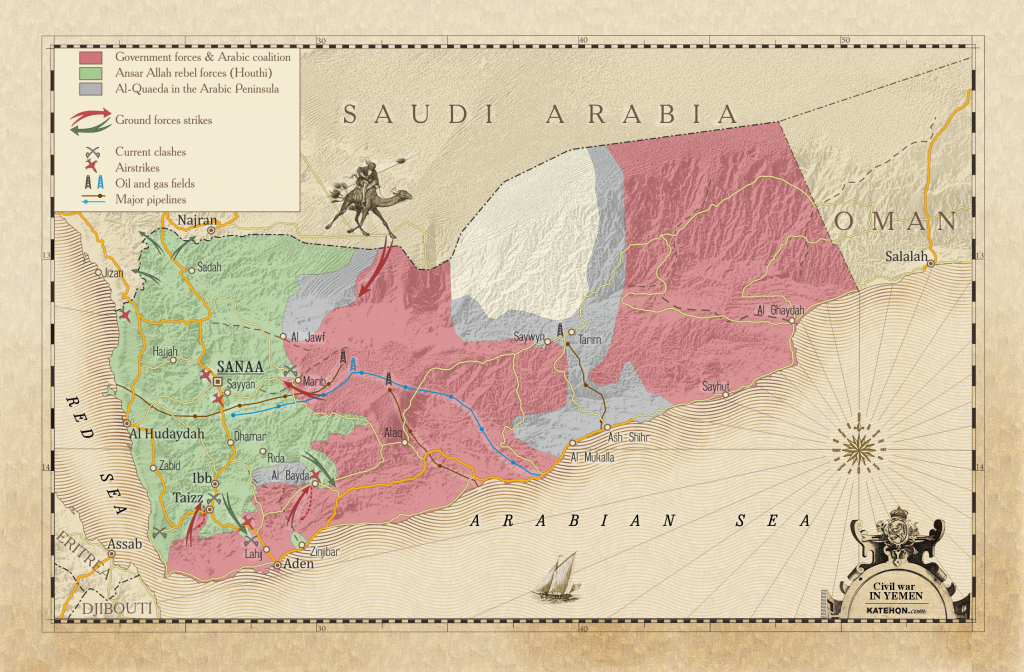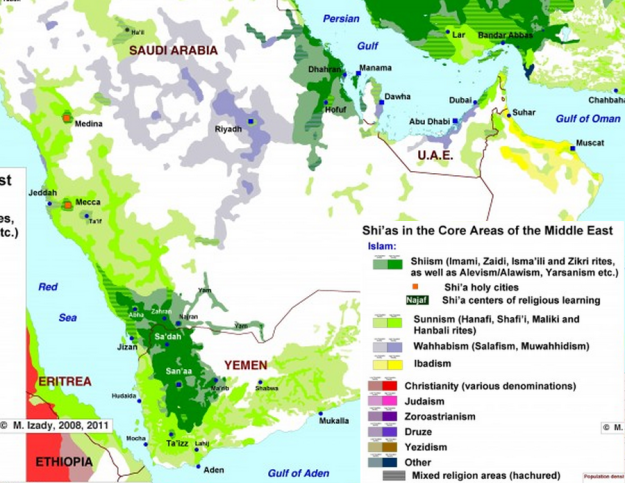
Originally appeared at Katehon
The Houthi forces recaptured Al-Kabeen region in Lahij province on Sunday night. Dozens of Saudi soldiers were killed and injured from the Yemeni forces’ assault. Meanwhile, the Yemeni army and popular forces made considerable advances in Marib province, killing a large number of Saudi forces and injuring many others.
The Saudi strategy in Yemen is suffering a complete collapse. Whilst multiple enemies are defeating Saudi forces, Houthi-rebels are aiming to occupy the southern provinces of Saudi Arabia.
Strategical importance of Yemen
Yemen is a country of great geopolitical importance. It is situated in the southwestern part of the Arabian Peninsula and guards the Bab al-Mandab Strait. It is an important country in geopolitical, military, and political terms. The industrialized countries of Western Europe depend on oil from the Persian Gulf, and the shortest route for tankers is through the Bab al-Mandab Strait, the Red Sea, and the Suez Canal. Thus, the strait is important for Europe and the Gulf countries, as well as Iran, which is seeking to renew its oil supply to Europe now that the sanctions have been lifted.
This maritime route is also important for China, who wants to include it in its project of the Maritime Silk Road. Last year, China negotiated with Djibouti the establishment of a military base in the Bab al-Mandab Strait on the African side.
As an entry point to the Red Sea, the Bab al-Mandab Strait, and therefore Yemen, are of great interest to Israel given its interest in the Red Sea. From a strategic point of view, whatever power controls Yemen also controls access to the strait and the maritime route from the Indian Ocean to the Mediterranean.
During the Cold War, Yemen represented a battlefield between Tellurocratic and Thalassocratic powers. The major continental power, the Soviet Union, managed to seize control of Southern Yemen, a former British colony, gaining control over the port of Aden near the Bab al-Mandab Strait. After the collapse of the Soviet Union, unified Yemen fell under Saudi influence.
The Shia Crescent on the Arabian Peninsula
The Northern part of Yemen is populated by Zaydi Shi’a Muslims, who have always been influenced by their co-religionists in Iran.
At the beginning of the 20th century, this moderate Shiite sect established its own Mutawakkilite Kingdom, led by a Zaidayyih Shiite religious leader, in the territory of Northern Yemen. This force always guaranteed Iranian interests and was supported by Iran during the previous civil war in 1962-1970. Despite the difference in regime (monarchy in the past, Islamic Republic today), Iran has the same allies and continues to show the same interest in Yemen and the same geopolitical strategy.
It is significant that the Saudi Najran region, which borders Yemen, is populated by Shia Sulaimani Ismailis, who are ethnically close to the population of Northern Yemen and are oppressed by the Wahhabi leadership of the kingdom. 10% of the Saudi population is Shia-Muslims. They populate the part of the country that is close to the Persian Gulf where the major oil reserves are situated. By supporting the oppressed Shia population in the Saudi kingdom, Iran can eventually destroy its main enemy in the Middle East. In turn, Saudi Arabia firstly wants to eradicate the Houthi rule in Yemen, and at the same time terrorize its own Shia population (e.g. execution of Nimr al-Nimr, a prominent Shia Sheikh).

Yemen war
Yemen remains fractured since President Hadi, in January of 2015, was ousted from the capital and went into exile. The country is torn between the Houthi led Interim government (Shia rebels backed by Iran), remnants of the former regime, AQAP, and a secession movement in the south; none are capable of controlling the entire country. In March 2015, Saudi Arabia initiated a military intervention in the country.
While the Houthi led government, supported by troops loyal to former president Saleh (predecessor of Hadi, ousted by the results of the Arab Spring in Yemen), is dominating in former Northern Yemen, the opposite forces, including Wahhabi invaders, ISIS, Al Qaeda on the Arabian Peninsula, and the separatist Southern Movement are fighting for former South Yemen.
The Saudi-led coalition includes the United Arab Emirates, Kuwait, Qatar, Bahrain, Jordan, Morocco, Sudan, Egypt, and Pakistan. The United States announced that they were assisting them with intelligence, targeting, and logistics.
Saudi Defeat in Yemen
Saudi Arabia cannot win the war in Yemen. The efforts of the Saudi-led coalition have not brought real success. The war reveals the military and strategic impotence of the Saudi command and leadership.
The kingdom cannot defeat the main enemy – the Houthi led government. The Houthis control the Yemeni capital Sana, and most of the former Northern Yemen.
The Saudi proxy, Al-Qaeda of the Arabian Peninsula, acts more independently. It is capturing more and more cities previously controlled by the Hadi-government supported by Riyadh.
At the same time, Southern separatists from the former PDRY have cut off the entire Hadhramaut region.
Houthi success
Not one of the Saudi’s strategical aims has been completed. Both Saleh and Houthi commanders are alive, and control large parts of Yemen, moving freely through the country. Houthi rebels use tactical ballistic missiles including SCUD, Tochka, and Qaher-1 against interventionist forces, hitting bases on Saudi territory and destroying the ships of the coalition. Jizan airport, Aramco oil installations, and the Faisal military base were all attacked.
According to independent sources, support for the Houthi movement in Yemen is growing. They managed to present themselves as the only independent force that opposes Saudi aggression and defends the principles of traditional Islam without Wahhabi perversions. In October 2015, they urged prominent tribesmen, intellects, and religious leaders from all parts of Yemen to sign the “tribal honor charter” to deter Saudi aggression.
War on Saudi soil
Houthi-rebels, with the support of local tribes torn from Saudi Arabia, are now attacking the province of Najran, and have invaded Jizan, capturing another Saudi base. The forces of the Houthi-government and the army of former president Saleh continuously attack the outskirts of the capital of the province.
The offensive was developed strictly in accordance with the precepts of Houthi (Zaydi) Imams who have always believed that Ismaili Najran and Jizan are parts of greater Yemen.
The Saudi army uses cluster bombs against its own population in a desperate attempt to stop the Yemen offensive.
Saudi Arabia and their allies are trying to salvage the situation by using mercenaries from all over the world, including Latin America (specifically Columbia) and the US. Houthi forces have managed to kill some of the mercenary commanders.
Actually this strategy indicates the defeat of the Saudi-led forces and can be easily connected to the environment of low oil prices, as revenues from oil are insufficient.
Forecast
Saudi Arabia is forecasted to lose the war. The impasse that is the Yemeni war could be the beginning of the collapse of the kingdom. This could lead to drastic changes in the region.
According to Yemeni army spokesman Brigadier-General Sharaf Ghalib Luqman, further attacks on Saudi provinces would be considered a political decision, not a military one, and the principal decision will be made in Tehran, not Sanaa.






Mistake: the Latin american country is called Colombia and not Columbia, it’s the second time I see this mistake in this page, please be aware. Thanks
Wahhabism of Saudis reaches its own setted doom.